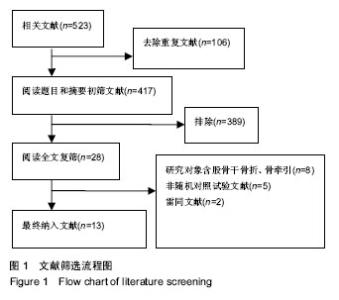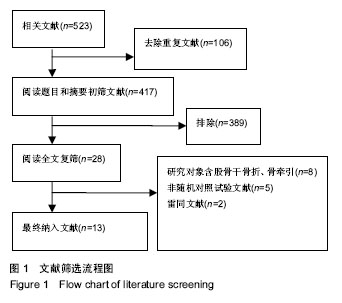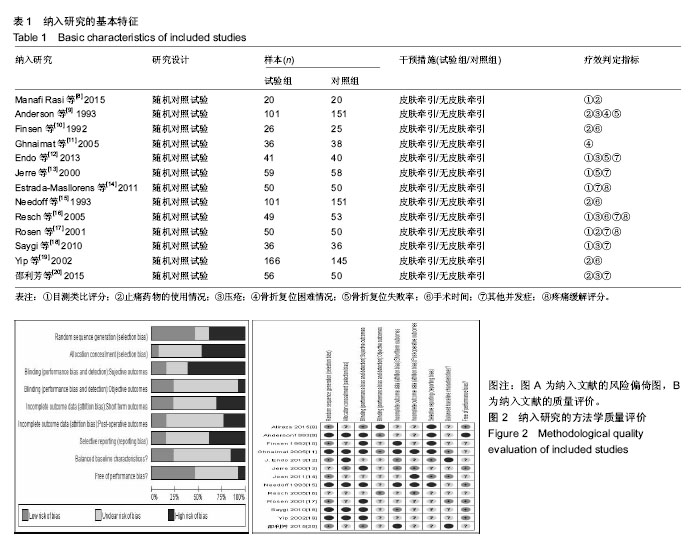Chinese Journal of Tissue Engineering Research ›› 2019, Vol. 23 ›› Issue (16): 2594-2600.doi: 10.3969/j.issn.2095-4344.1216
Previous Articles Next Articles
Preoperative skin traction for hip fractures: a systematic review
Wei Zhihui1, Zhang Minghua1, Zhang Zhongzu1, Jiang Lian2
- 1Department of Orthopedics, 2Department of Geriatrics, the Affiliated Yongchuan Hospital, Chongqing Medical University, Chongqing 402160, China
-
Online:2019-06-08Published:2019-06-08 -
Contact:Jiang Lian, Master, Physician, Department of Geriatrics, the Affiliated Yongchuan Hospital, Chongqing Medical University, Chongqing 402160, China -
About author:Wei Zhihui, Master, Physician, Department of Orthopedics, the Affiliated Yongchuan Hospital, Chongqing Medical University, Chongqing 402160, China
CLC Number:
Cite this article
Wei Zhihui, Zhang Minghua, Zhang Zhongzu, Jiang Lian. Preoperative skin traction for hip fractures: a systematic review [J]. Chinese Journal of Tissue Engineering Research, 2019, 23(16): 2594-2600.
share this article
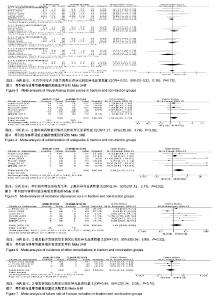
2.3 Meta分析结果 2.3.1 疼痛目测类比评分 采用疼痛目测类比评分进行评估,有7个研究共1 445例患者比较了2种治疗方式术后不同时间的疼痛目测类比评分并进行亚组分析[8,13-14,16-18,20],其中牵引组726例,非牵引组719例。各研究结果间有统计学异质性(P=0.000 2,I2=61%),选用随机效应模型。Meta分析结果显示,2组比较差异无显著性意义[OR=-0.02,95%CI(-0.22,0.19),P=0.78]。亚组分析结果显示,干预30 min内疼痛目测类比评分[OR=-0.05,95%CI(-0.26,0.17),P=0.66]、干预1 h后疼痛目测类比评分[OR=0.14,95%CI(-0.20,0.49),P=0.41]、干预4 h后疼痛目测类比评分[OR=0.02,95%CI(-0.38,0.42),P=0.93、干预12 h后疼痛目测类比评分[OR=-0.36,95%CI(-1.09,0.38),P=0.34]和干预24 h后疼痛目测类比评分[OR=-0.02,95%CI(-1.10,1.06),P=0.97],2组的疼痛目测类比评分差异均无显著性意义,见图3。 2.3.2 止痛药物的使用情况 有6个研究共1 072例患者比较2组疼痛药物的使用情况[9-10,15,17,19-20],其中牵引组500例,非牵引组572例,各研究结果间无统计学异质性(P=0.78,I2=0%),选用固定效应模型。Meta分析结果显示,牵引组与非牵引组在疼痛药物的使用情况上差异无显著性意义[OR=1.31,95%CI(0.96,1.79),P=0.08],见图4。 2.3.3 压疮 有6个研究733例患者比较压疮发生例 数[9,12-13,16,18,20],各研究结果间无统计学异质性(P=0.42,I2=0%),选用固定效应模型。Meta分析结果显示,牵引组和非牵引组压疮发生情况差异有显著性意义[OR=2.04,95%CI(1.12,3.71),P=0.02],见图5。 2.3.4 其他并发症 有6个研究共521例患者比较2组其他并发症的发生情况[12-14,16,18,20],包括静脉血栓、神经炎、肺部感染等,其中牵引组263例,非牵引组258例,各研究结果间有统计学异质性(P=0.06,I2=52%),选用随机效应模型。Meta分析结果显示,牵引组与非牵引组在其他并发症发生率上差异无显著性意义[OR=1.81,95%CI(0.56,5.88),P=0.32],见图6。 2.3.5 骨折复位失败率 有3个研究共453例患者比较2组骨折复位失败率[9,12-13],其中牵引组202例,非牵引组251例,各研究结果间无统计学异质性(P=0.80,I2=0%),选用固定效应模型。Meta分析结果显示,牵引组与非牵引组在骨折复位失败率上差异无显著性意义[OR=0.84,95%CI (0.34,2.09),P=0.70],见图7。"
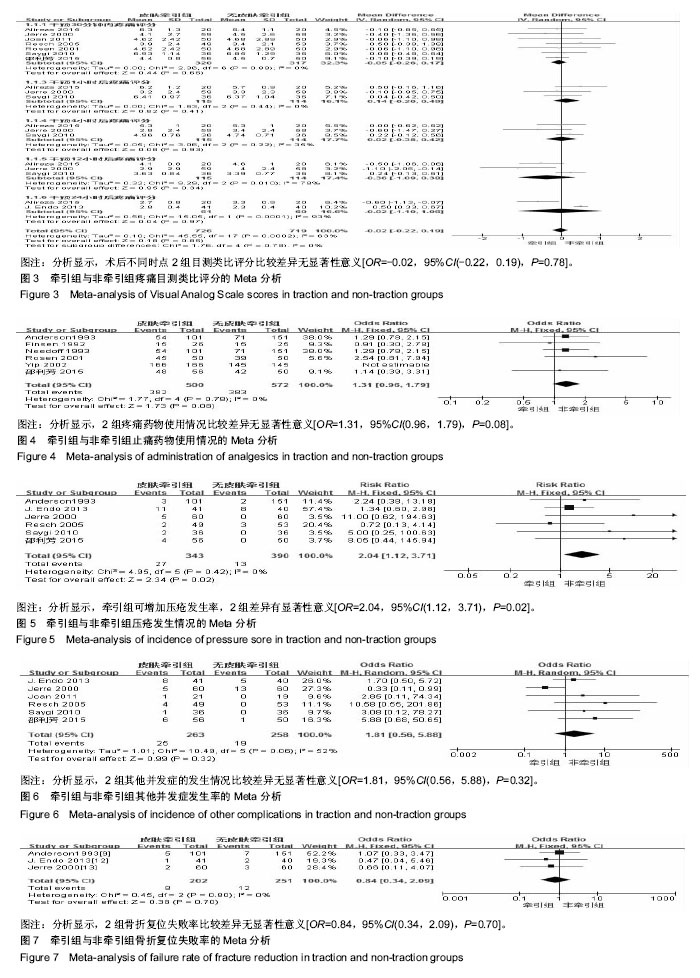
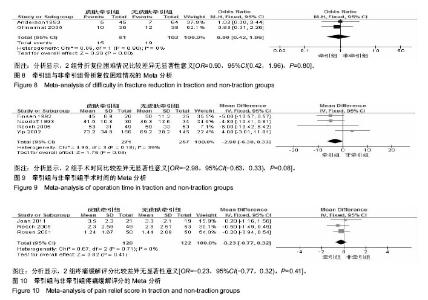
2.3.6 骨折复位困难情况 有2个研究共183例患者比较2组骨折复位困难情况[9,11],其中牵引组81例,非牵引组102例,各研究结果间无统计学异质性(P=0.80,I2=0%),选用固定效应模型。Meta分析结果显示,牵引组与非牵引组在骨折复位困难情况上差异无显著性意义[OR=0.90,95%CI (0.42,1.96),P=0.80] ,见图8。2.3.7 手术时间 有4个研究共528例患者比较2组的手术时间[10,15-16,19],其中牵引组271例,非牵引组257例,各研究结果间无统计学异质性(P=0.18,I2=39%),选用固定效应模型。Meta分析结果显示,牵引组与非牵引组的手术时间差异无显著性意义[OR=-2.98,95%CI(-0.63,0.33),P=0.08],见图9。 2.3.8 疼痛缓解评分 有3个研究共242例患者比较2组疼痛缓解评分[14,16-17],其中牵引组120例,非牵引组122例,各研究结果间无统计学异质性(P=0.71,I2=0%),选用固定效应模型。Meta分析结果显示,牵引组与非牵引组在疼痛缓解评分上差异无显著性意义[OR=-0.23,95%CI(-0.77,0.32),P=0.41] ,见图10。"
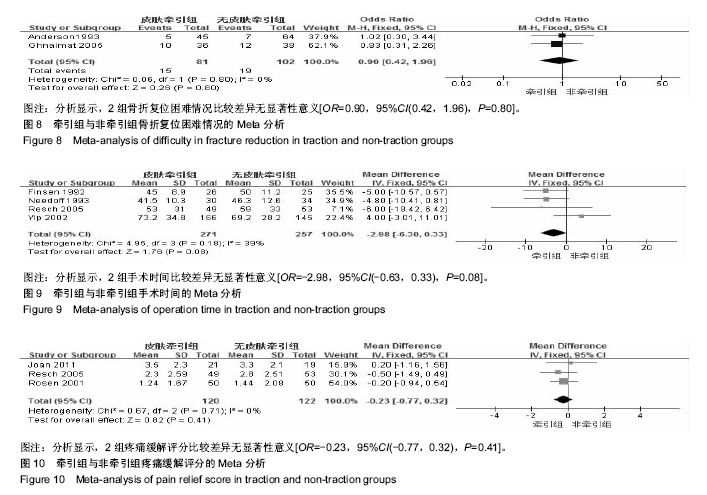
| [1] 张英泽.临床创伤骨科流行病学[M].北京:人民卫生出版社, 2009: 150-170.[2] Koh LK, Saw SM, Lee JJ, et al. Hip fracture incidence rates in Singapore 1991-1998. Osteoporos Int. 2001;12(4):311-318.[3] Bjorgul K, Reikeras O. Incidence of hip fracture in southeastern Norway: a study of 1730 cervical and trochanteric fractures. Inte Orthop. 2007;31(5):665-669. [4] 邱贵兴,裴福兴,胡侦明,等.中国骨质疏松性骨折诊疗指南(骨质疏松性骨折诊断及治疗原则)[J].中华骨与关节外科杂志, 2015, 8(5):371-374.[5] Hoenig H, Rubenstein LV, Sloane R, et al. What is the role of timing in the surgical and rehabilitative care of community-dwelling older persons with acute hip fracture? Arch Intern Med.1997;157:485-486.[6] Resch S, Thorngren KG. Preoperative traction for hip fracture: A randomized comparison between skin and skeletal traction in 78 patients. Acta Orthop Scand. 1998;69:277-279. [7] Anders RL, Ornellas EM. Acute management of patients with hip fracture. A research literature review. Orthop Nurs.1997;16(2): 31-46. [8] Manafi Rasi A, Amoozadeh F, Khani S, et al. The effect of skin traction on preoperative pain and need for analgesics in patients with intertrochanteric fractures: a randomized clinical trial. Arch Trauma Res. 2015;4(2): e12039.[9] Anderson GH, Harper WM, Connolly CD, et al. Preoperative skin traction for fractures of the proximal femur. A randomised prospective trial. J Bone Joint Surg Br. 1993;75(5):794-796.[10] Finsen V, Børset M, Buvik GE, et al. Preoperative traction in patients with hip fractures. Injury. 1992;23(4):242.[11] Ghnaimat M, Aldweri M, Hijazi A, et al. Preoperative skin traction for fractures of the proximal femur. J Bahr Med Soc. 2005;17(4):240-242.[12] Endo J, Yamaguchi S, Saito M, et al. Efficacy of preoperative skin traction for hip fractures: a single-institution prospective randomized controlled trial of skin traction versus no traction. J Orthop Sci. 2013;18(2): 250-255.[13] Jerre R, Doshe A, Karlsson J. Preoperative treatment in patients with hip fractures is not useful. Clin Orthop Relat Res. 2000;(378):169-173.[14] Estrada-Masllorens JM, Cabrera-Jaime S. Randomised clinical trial on pain control in intertrochanteric fractures of the femur with and without skin traction. Enferm Clin.2011;21(5): 264-270.[15] Needoff M, Radford P, Langstaff R. Preoperative traction for hip fractures in the elderly: a clinical trial. Injury. 1993;24(5): 317-318.[16] Resch S, Bjärnetoft B, Thorngren KG. Preoperative skin traction or pillow nursing in hip fractures: a prospective, randomized study in 123 patients. Disability & Rehabilitation. 2005;27(18-19):1191-1195.[17] Rosen J, Chen FR, Koval K. Efficacy of preoperative skin traction in hip fracture patients: a prospective, randomized study. J Orthop Trauma.2001;15(2):81-85.[18] Saygi B, Ozkan K, Eceviz E, et al. Skin traction and placebo effect in the preoperative pain control of patients with collum and intertrochanteric femur fractures. Bull NYU Hosp Jt Dis. 2010;68(1):15-17.[19] Yip D, Chan C, Chiu PK, et al. Why are we still using pre- operative skin traction for hip fractures? Int Orthop. 2002; 26(6):361-364.[20] 邵利芳,夏晓斌,鲍荣华. 术前皮牵引对髋部骨折疼痛改善及复位的影响[J].上海交通大学学报(医学版),2015,35(6):851-854.[21] Billsten M, Besjakov J, Hyddmark U, et al. Enquiry in Sweden on the use of traction preoperatively in patients with hip fracture and a radiological study on the effect of the traction on ten displaced cervical hip fractures. Acta Orthopaedica Scandinavica.1996;270:35.[22] Brink AC, Boonstra O, van Der Wal BCH, et al. Is preoperative traction for proximal femoral fractures bene?cial to the patient or a comfort to the doctor? Eur J Trauma. 2005;31(1):39-43.[23] Lindholm C, Sterner E, Romanelli M, et al. Hip fracture and pressure ulcers -the Pan-European Pressure Ulcer Study- intrinsic and extrinsic risk factors. Int Wound J.2008;5(2):312-328. [24] Ooi LH, Wong TH, Toh CL, et al. Hip fractures in nonagenarians-a study on operative and non-operative management. Injury. 2005;36(1): 142-147.[25] Loo WL, Loh SY, Lee HC. Is there a signi?cant difference in surgery and outcomes between unipolar and bipolar hip hemiarthroplasty? A retrospective study of a single institution in Singapore. Malays Orthop J. 2011;5(1):3-7.[26] Micic ID, Mitkovic MB, Park IH, et al. Treatment of subtrochanteric femoral fractures using selfdynamisable internal fixator. Clin Orthop Surg. 2010;2:227-231. [27] Donegan DJ, Gay AN, Baldwin K, et al. Use of medical comorbidities to predict complications after hip fracture surgery in the elderly. J Bone Joint Surg Am. 2010;92: 807-813.[28] Gregory JJ, Kostakopoulou K, Cool WP, et al. One-year outcome for elderly patients with displaced intracapsular fractures of the femoral neck managed non-operatively. Injury. 2010; 41(12):1273-1276.[29] Parker MJ, Handoll HHG. Pre-operative traction for fractures of the proximal femur in adults. Cochrane Database Syst Rev. 2006;(3):CD000168. [30] Strömqvist B, Nilsson LT, Egund N, et al. Intracapsular pressures in undisplaced fractures of the femoral neck. J Bone Joint Surg Br.1988;70:192-194.[31] Queally JM, Parker MJ. Pre-operative traction for hip fractures in adults. Cochrane Database Syst Rev. 2011;7(12): CD000168.[32] Even JL, Richards JE, Crosby CG, et al. Preoperative skeletal versus cutaneous traction for femoral shaft fractures treated within 24 hours. J Orthop Trauma. 2012;26(10):e177-182.[33] 刘雪梅.老年人股骨颈骨折皮牵引术的护理[J]. 医学理论与实践,2011,24(20): 2494-2495.[34] 刘秀莹,刘秀荣,张秀英,等.神经科病房消灭褥疮的几点体会[J].中华护理杂志,1996,31(3):180-181.[35] Peirce SM, Skalak TC, Rodeheaver GT. Ischemia-reperfusion injury in chronic pressure ulcer formation: a skin model in the rat. Wound Repair Regen. 2000;8(1):68-76.[36] 徐云侠,胡守紫,钟政荣,等. 压迫时间与压疮发生关系的实验研究[J]. 蚌埠医学院学报,2015,40(7):854-856.[37] 张水兰,时红梅.压疮的护理进展[J].实用护理杂志,2002,18(11): 60-61. |
| [1] | Du Xiupeng, Yang Zhaohui. Effect of degree of initial deformity of impacted femoral neck fractures under 65 years of age on femoral neck shortening [J]. Chinese Journal of Tissue Engineering Research, 2021, 25(9): 1410-1416. |
| [2] | Zeng Yanhua, Hao Yanlei. In vitro culture and purification of Schwann cells: a systematic review [J]. Chinese Journal of Tissue Engineering Research, 2021, 25(7): 1135-1141. |
| [3] | Cai Qunbin, Zou Xia, Hu Jiantao, Chen Xinmin, Zheng Liqin, Huang Peizhen, Lin Ziling, Jiang Ziwei. Relationship between tip-apex distance and stability of intertrochanteric femoral fractures with proximal femoral anti-rotation nail: a finite element analysis [J]. Chinese Journal of Tissue Engineering Research, 2021, 25(6): 831-836. |
| [4] | Lü Jiaxing, Bai Leipeng, Yang Zhaoxin, Miao Yuesong, Jin Yu, Li Zhehong, Sun Guangpu, Xu Ying, Zhang Qingzhu. Evaluation of internal fixation with proximal femoral nail antirotation in elderly knee osteoarthritis patients with femoral intertrochanteric fractures [J]. Chinese Journal of Tissue Engineering Research, 2021, 25(3): 391-396. |
| [5] | Liu Chang, Han Shufeng. Interlocking intramedullary nail for proximal femur versus proximal femoral anti-rotation intramedullary nail or proximal femoral anti-rotation intramedullary nail of Asian for intertrochanteric fractures in older adults: a meta-analysis [J]. Chinese Journal of Tissue Engineering Research, 2021, 25(3): 477-485. |
| [6] | Nie Shaobo, Li Jiantao, Sun Jien, Zhao Zhe, Zhao Yanpeng, Zhang Licheng, Tang Peifu. Mechanical stability of medial support nail in treatment of severe osteoporotic intertrochanteric fracture [J]. Chinese Journal of Tissue Engineering Research, 2021, 25(3): 329-333. |
| [7] | Cheng Shigao, , Wang Wanchun, Jiang Dong, Li Tengfei, Li Xun, Ren Lian. Comparison of the standard and long-stem bone cement prosthesis replacement in the treatment of intertrochanteric fractures in elderly patients [J]. Chinese Journal of Tissue Engineering Research, 2021, 25(3): 362-367. |
| [8] | Wang Yihan, Li Yang, Zhang Ling, Zhang Rui, Xu Ruida, Han Xiaofeng, Cheng Guangqi, Wang Weil. Application of three-dimensional visualization technology for digital orthopedics in the reduction and fixation of intertrochanteric fracture [J]. Chinese Journal of Tissue Engineering Research, 2021, 25(24): 3816-3820. |
| [9] | Su Baotong, Wang Hanyu, Xu Yilang, Xie Yajuan, Cheng Zhian. Construction of a Nomogram prediction model for postoperative delirium after hip fracture in the elderly based on medical records from a hospital [J]. Chinese Journal of Tissue Engineering Research, 2021, 25(24): 3844-3849. |
| [10] | Tian Kechao, Wang Lei, Tao Yong, Yao Tao. Proximal femoral nail antirotation combined with posteromedial wall reconstruction for the treatment of type A2 intertrochanteric fracture in the elderly [J]. Chinese Journal of Tissue Engineering Research, 2021, 25(21): 3337-3342. |
| [11] | Cai Qunbin, Yang Lijuan, Li Qiumin, Chen Xinmin, Zheng Liqin, Huang Peizhen, Lin Ziling, Jiang Ziwei . Feasibility of internal fixation removal of intertrochanteric fractures in elderly patients based on fracture mechanics [J]. Chinese Journal of Tissue Engineering Research, 2021, 25(21): 3313-3318. |
| [12] | Wang Hao, Wang Yitao, Lü Zexiang, Li Tengfei, Wang Shaolong, Wang Yehua. Effect of repeated intravenous tranexamic acid in the perioperative period of proximal femoral nail antirotation for femoral intertrochanteric fracture [J]. Chinese Journal of Tissue Engineering Research, 2021, 25(21): 3319-3323. |
| [13] | Song Kaikai, Du Gangqiang, Li Peng, Jiang Shengyuan, Gong Zhihao, Zhang Zhiwei, Zhang Kai . Application of head-neck ratio in the treatment of femoral neck fracture in aged patients with artificial femoral head replacement [J]. Chinese Journal of Tissue Engineering Research, 2021, 25(18): 2805-2809. |
| [14] | Li Haifeng, Liu Yu, Yin Qudong, Sun Zhenzhong, Rui Yongjun, Gu Sanjun. Risk of complications of early postoperative weight-bearing after internal fixation of intracapsular femoral neck fractures: 2-year follow-up [J]. Chinese Journal of Tissue Engineering Research, 2021, 25(18): 2875-2880. |
| [15] | Yang Kun, Fei Chen, Wang Pengfei, Zhang Binfei, Yang Na, Tian Ding, Zhuang Yan, Zhang Kun . Meta-analysis of the efficacy of robot-assisted and traditional manual implantation of cannulated screws in the treatment of femoral neck fracture [J]. Chinese Journal of Tissue Engineering Research, 2021, 25(18): 2938-2944. |
| Viewed | ||||||
|
Full text |
|
|||||
|
Abstract |
|
|||||
